About our church
What We
Believe
Our Vision
To make disciples of Jesus Christ by sharing God’s love and grace in our church, community and world, that all would be transformed.
Our Mission
Opening doors with Christ, one another and our neighbors.
Our Core Values
Lifelong Learner
We believe that God always has something to teach us, and our hearts and minds are open to what He wants to share.
Praying Follower
We believe in building a deep connection with God through praying authentic prayers as individuals and as a body of believers.
Passionate Worshipper
We believe in honoring the Lord through meaningful worship in a variety of ways – on Sunday mornings and throughout the week.
Dedicated Missionary
We believe that God’s love is meant to be shared with everyone. We’re committed to humbly serving others and sharing the hope of Christ in our community and beyond.
Relationship Builder
We believe that God intends for us to go through life together. We prioritize cultivating connections, building one another up and caring for one another.
Generous Giver
We believe that we’re called to be faithful stewards of all that God has provided and work to use our blessings to bless others.
Our History
We are a part of the Susquehanna Conference of the United Methodist Church. To learn more about our denomination’s history and beliefs, visit susumc.org.
Scroll through the timeline to learn more about our church’s story.
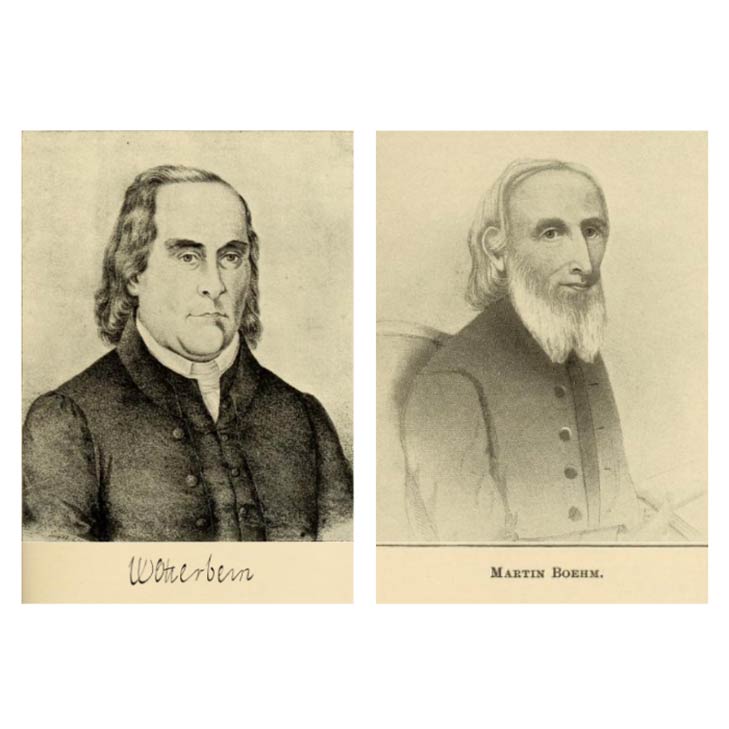
1767
The Church of the United Brethren
In 1767, German Reformed minister William Otterbein, shared a “great meeting” with Martin Boehm, a Mennonite bishop in a barn north of Lancaster, Pa. Boehm told his story of becoming a Christian and a minister. The story deeply moved Otterbein, who left his seat, embraced Boehm, and said loud enough for everyone to hear, “we are brethren.” In 1789 Otterbein presided over a meeting in Baltimore of ministers who shared his beliefs. The group grew to include pastors who had been associated with the German Reformed, Lutheran and Mennonite churches. In September 1800, the group officially formed the Church of the United Brethren in Christ in Frederick, Maryland. Otterbein and Boehm were elected bishops of this newly formed denomination.
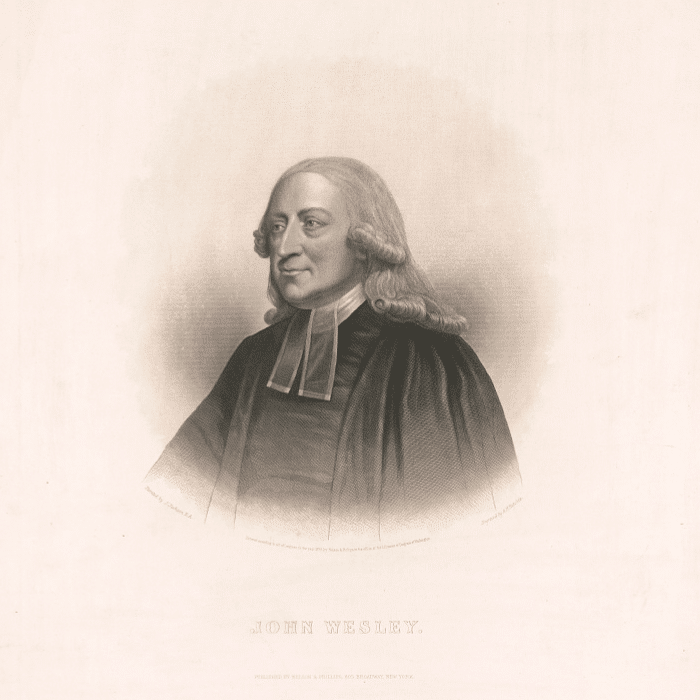
1783
Methodism Comes to America
In 1783, English clergyman John Wesley sent Dr. Thomas Coke to America to ordain Bishop Frances Asbury in Baltimore. The Methodist Church grew throughout the region. The Methodists devised a new type of minister: the circuit rider. Instead of being tied to a single church, pastors would ride hundreds of miles each month in their circuits to visit remote farms. These circuit riders would comfort, counsel, marry young couples, baptize children and bury the dead.
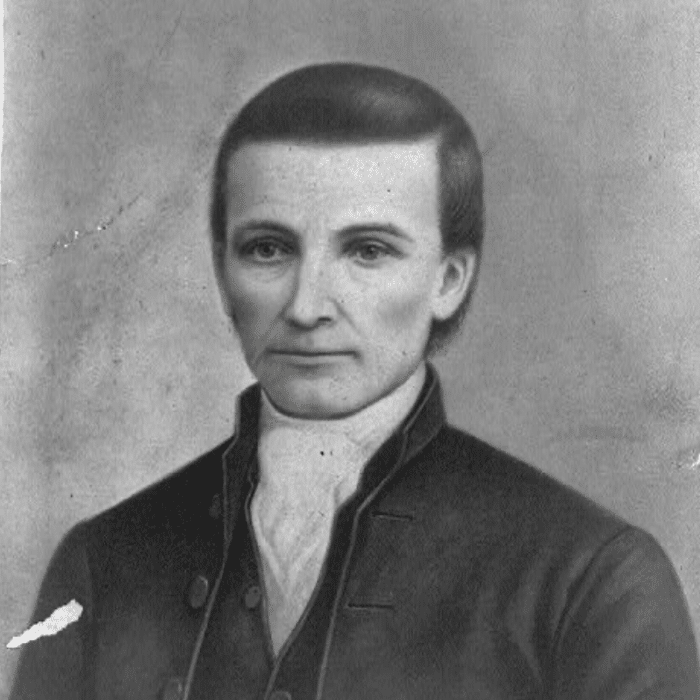
1803
The Evangelical Association
In 1803, Jacob Albright established the Evangelical Association, a denomination with similar beliefs to the United Brethren Church. The Evangelical Association ministered to German-speaking immigrants who had settled in the Cumberland Valley. While they all shared similar theology, the Methodists served English-speaking congregations, while the United Brethren and Evangelicals ministered to German-speaking populations.
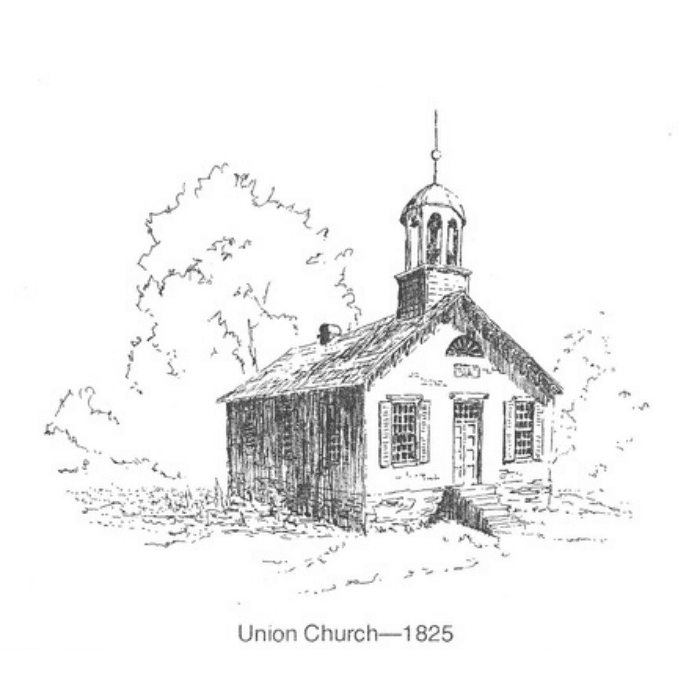
1827
The Beginnings of First Church
First United Methodist Church congregation has its roots in the Shopp's United Brethren Church of Shiremanstown, Pa. Shopp’s Church was a “station” for the United Brethren circuit rider pastors, who served various congregations throughout the region. The United Brethren met in John Shopp’s home until a church was built on his farm in 1827.

1848
Jacob Coover, Founding Father
In 1848, the Rev. Jacob S. Kissler, United Brethren pastor of Shopp’s Station, was invited to preach in the old Union Church on East Main Street in Mechanicsburg. Union Church was not affiliated with any denomination, but served as a meeting place for a variety of local congregations that did not maintain a house of worship. Jacob Coover, a Mechanicsburg native and passionate Christian, had attended a number of United Brethren services conducted by Rev. Kissler at Shiremanstown. This association inspired Coover to invite Rev. Kissler to preach in Mechanicsburg, which soon became a regular occurance.
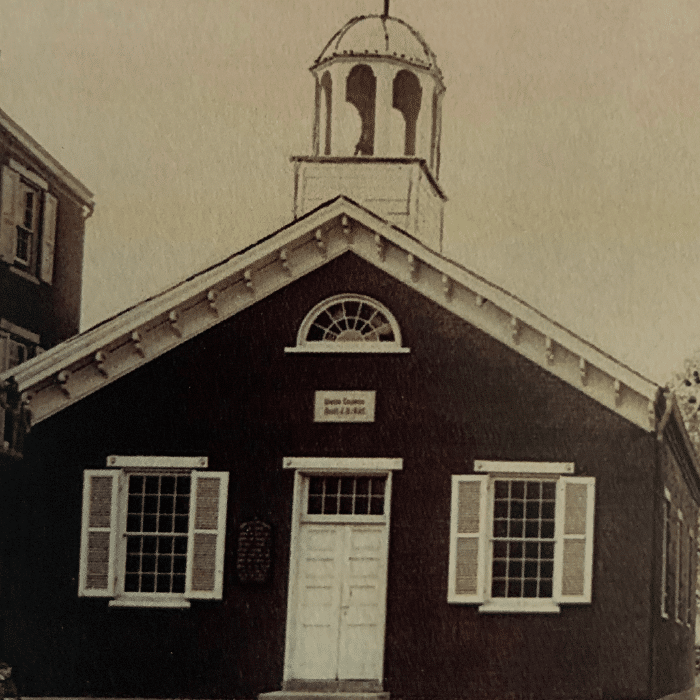
1850
Union Church
Soon after a number of services were held at Union Church, a class was formed in 1850 and recognized as a regular appointment connected with Shopp’s Station. In the years that followed, services were conducted by various circuit rider preachers from Shopp’s Station. The church numbers grew slowly until 1854, when a great revival was held. A spiritual awakening swept the town and the church membership increased significantly. Within a few short years, the congregation needed a larger worship space.
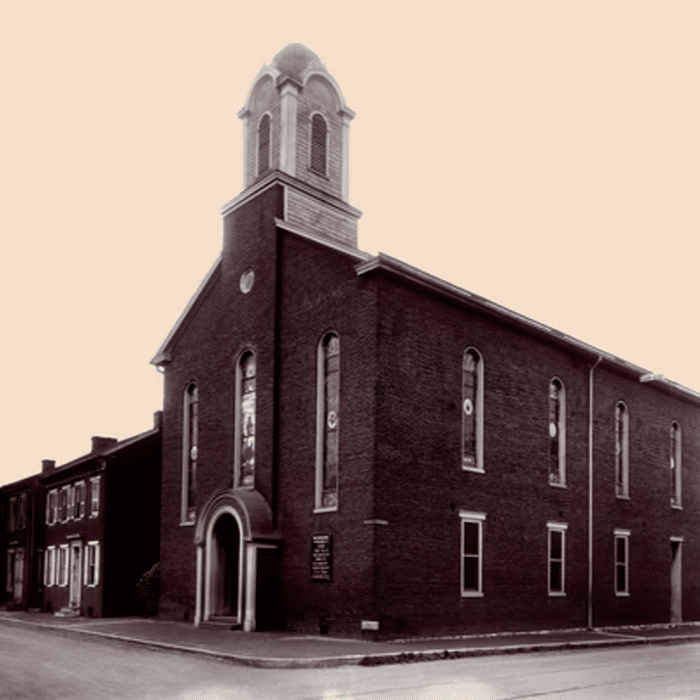
1857
Locust Street Church
The congregation purchased a lot on the northwest corner of Arch and Locust Streets and built a two-story frame church building at a cost of $3,400. The church membership, numbering 30 worshipers at this time, soon increased. Once a house of worship was built, a Sunday Church School was established. At the 1863 Annual Conference of the United Brethren in Christ Church, Mechanicsburg was made a Station and the Rev. W. B. Raber was appointed pastor. Membership at that time was 118.

1872
A New Building
The church continued to grow, and it became evident that again a new building was necessary. The frame church was torn down, and a new two story brick church was erected on the same site in 1871. The building was dedicated in 1872 and still stands on Locust Street. A parsonage down the street from the new building was gifted to the church as well. The total church budget for 1878 was $850.
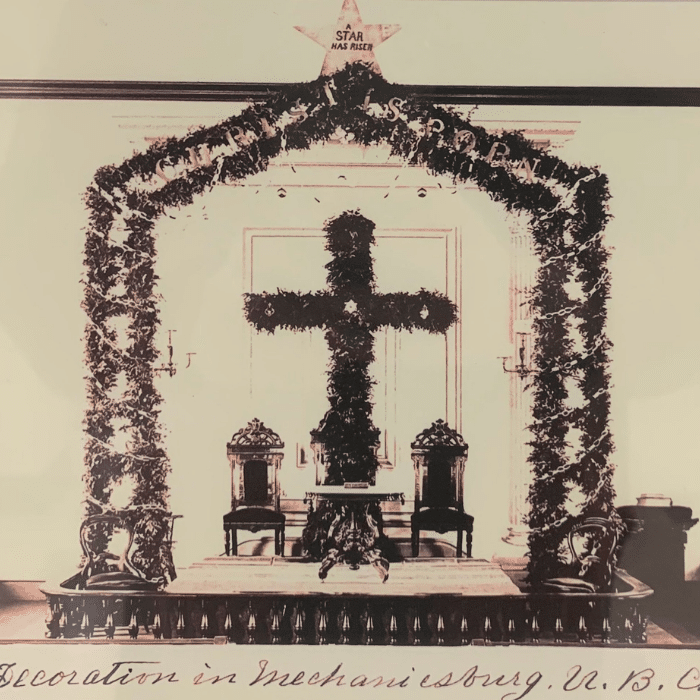
1885
Continuing to Grow
The Mechanicsburg church, known as the First United Brethren in Christ Church, continued to grow and prosper both spiritually and in membership. Conference minutes of 1885 reported 214 members, 275 on the Sunday School membership rolls plus 36 teachers and officers. As the congregation continued to grow, they quickly outgrew the recently-constructed building.
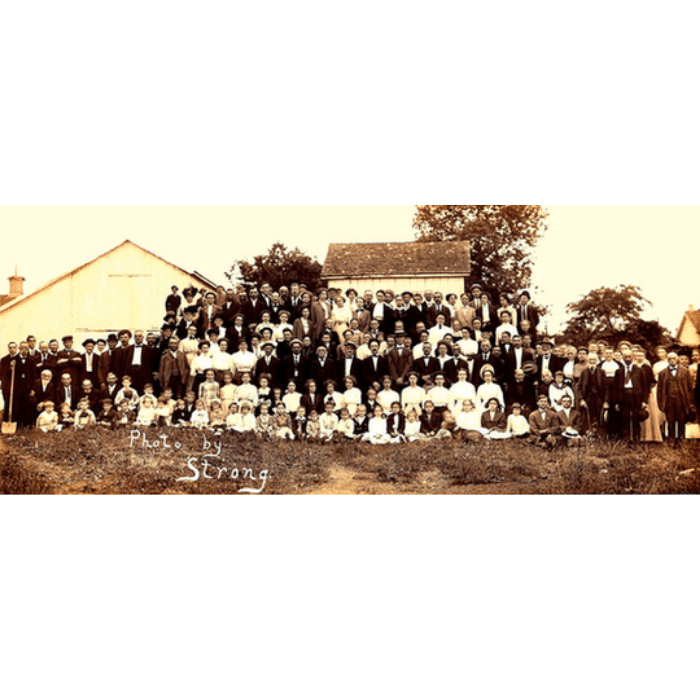
1911
The Move to Simpson Street
In 1905, the congregation purchased a lot at the corner of Frederick and Simpson Streets for $4,500. Soon after, another great revival added to an already growing congregation and new facilities became a necessity. The cornerstone of a new sanctuary was laid October 8, 1911, and the new church was dedicated February 2, 1913. On February 3, 1913, The Daily Journal, of Mechanicsburg, reported this new church as a “...handsome, massive and modern church edifice,” and thanked the congregation for “...giving to Mechanicsburg a church home of such grandeur.” The new church plant was a major commitment on the part of the congregation to nurture the work of the Lord at that time and for years to follow.
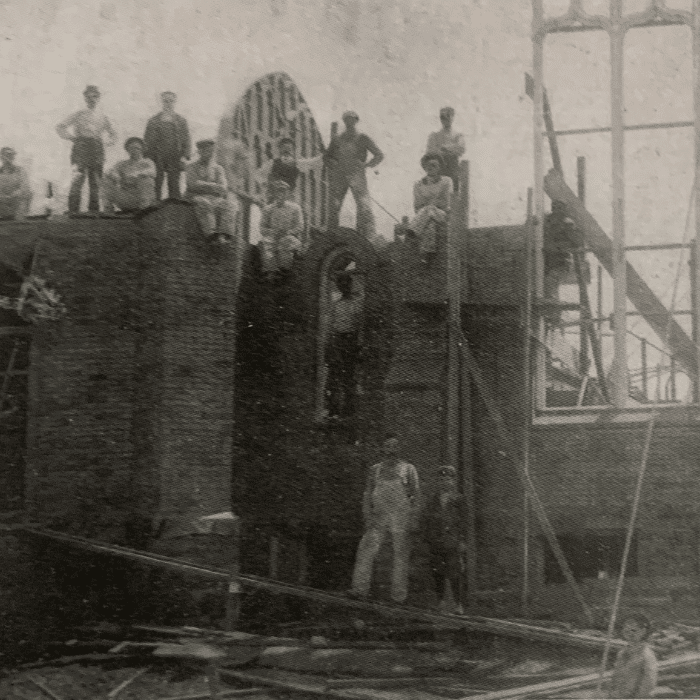
1946
The Merger with the Evangelical Church
On November 16, 1946, the Evangelical Church and the United Brethren Church merged to form the Evangelical United Brethren Church. In Mechanicsburg, the congregation became known as the First Evangelical United Brethren Church. Throughout the 1940s and 1950s, the First Church congregation expanded, and the building was upgraded as needed.

1962
The Need to Grow
In 1956, the congregation voted to purchase a plot of land immediately next to the church. The houses there provided rental income until First Church was ready to expand its main building into that space. After a worship service in April 1962, a groundbreaking ceremony kicked off a project to grow and upgrade the facilities. The Trustees and mason contractors laid the cornerstone for this new part of the building in July of the same year. In June 1963, the rehabilitated original structure and new facilities were dedicated.
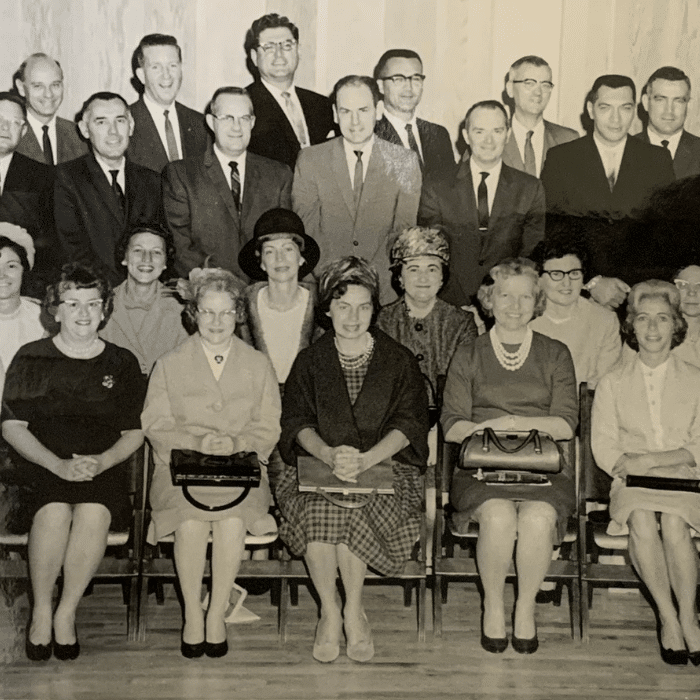
1968
The Merger with the Methodist Church
On April 23, 1968, Bishop Reuben H. Mueller, representing The Evangelical United Brethren Church, and Bishop Lloyd C. Wicke of The Methodist Church joined hands at the constituting General Conference in Dallas, Texas. With the words, "Lord of the Church, we are united in Thee, in Thy Church and now in The United Methodist Church," the new denomination was born. The congregation now identified as First United Methodist Church of Mechanicsburg.
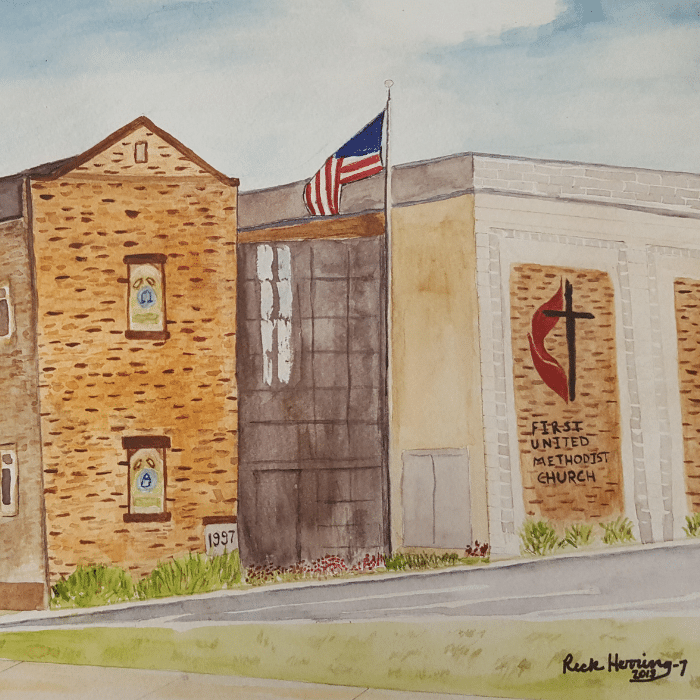
1997
Continued Expansion
As the 21st century approached, First Church continued to grow. The church completed a major expansion in 1998 to meet the congregation's new needs. This included a renovation of the sanctuary, refurbishing of classrooms, a new multipurpose room, an office suite and additional classrooms. This additional space continues to bless the congregation and community.

2000-2023
Launch of More Inclusive Worship
Over the years, worship has evolved at First Church to include a greater variety of people and honor God in new ways. In addition to our traditional Foundation service, we currently offer Rejoicing Spirits (specially designed for individuals with intellectual and developmental disabilities and their families) and our modern-style Gathering service (which evolved over the years from our more contemporary "First Light," "Psalm 150" and "Anchor" services, along with our blended "Convergent" service).
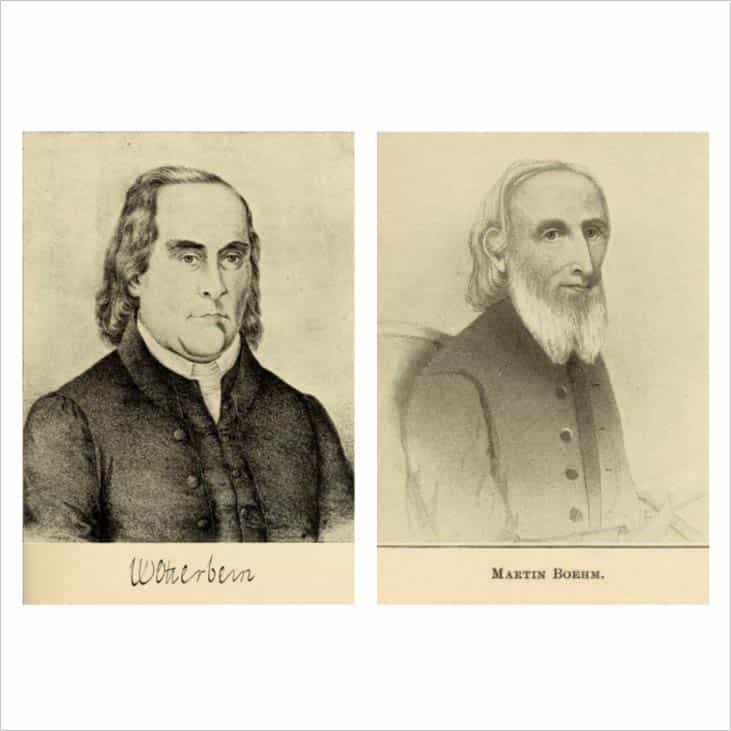
1767
The Church of the United Brethren
In 1767, German Reformed minister William Otterbein, shared a “great meeting” with Martin Boehm, a Mennonite bishop in a barn north of Lancaster, Pa. Boehm told his story of becoming a Christian and a minister. The story deeply moved Otterbein, who left his seat, embraced Boehm, and said loud enough for everyone to hear, “we are brethren.” In 1789 Otterbein presided over a meeting in Baltimore of ministers who shared his beliefs. The group grew to include pastors who had been associated with the German Reformed, Lutheran and Mennonite churches. In September 1800, the group officially formed the Church of the United Brethren in Christ in Frederick, Maryland. Otterbein and Boehm were elected bishops of this newly formed denomination.

1783
Methodism Comes to America
In 1783, English clergyman John Wesley sent Dr. Thomas Coke to America to ordain Bishop Frances Asbury in Baltimore. The Methodist Church grew throughout the region. The Methodists devised a new type of minister: the circuit rider. Instead of being tied to a single church, pastors would ride hundreds of miles each month in their circuits to visit remote farms. These circuit riders would comfort, counsel, marry young couples, baptize children and bury the dead.

1803
The Evangelical Association
In 1803, Jacob Albright established the Evangelical Association, a denomination with similar beliefs to the United Brethren Church. The Evangelical Association ministered to German-speaking immigrants who had settled in the Cumberland Valley. While they all shared similar theology, the Methodists served English-speaking congregations, while the United Brethren and Evangelicals ministered to German-speaking populations.

1827
The Beginnings of First Church
First United Methodist Church congregation has its roots in the Shopp's United Brethren Church of Shiremanstown, Pa. Shopp’s Church was a “station” for the United Brethren circuit rider pastors, who served various congregations throughout the region. The United Brethren met in John Shopp’s home until a church was built on his farm in 1827.

1848
Jacob Coover, Founding Father
In 1848, the Rev. Jacob S. Kissler, United Brethren pastor of Shopp’s Station, was invited to preach in the old Union Church on East Main Street in Mechanicsburg. Union Church was not affiliated with any denomination, but served as a meeting place for a variety of local congregations that did not maintain a house of worship. Jacob Coover, a Mechanicsburg native and passionate Christian, had attended a number of United Brethren services conducted by Rev. Kissler at Shiremanstown. This association inspired Coover to invite Rev. Kissler to preach in Mechanicsburg, which soon became a regular occurance.

1850
Union Church
Soon after a number of services were held at Union Church, a class was formed in 1850 and recognized as a regular appointment connected with Shopp’s Station. In the years that followed, services were conducted by various circuit rider preachers from Shopp’s Station. The church numbers grew slowly until 1854, when a great revival was held. A spiritual awakening swept the town and the church membership increased significantly. Within a few short years, the congregation needed a larger worship space.

1857
Locust Street Church
The congregation purchased a lot on the northwest corner of Arch and Locust Streets and built a two-story frame church building at a cost of $3,400. The church membership, numbering 30 worshipers at this time, soon increased. Once a house of worship was built, a Sunday Church School was established. At the 1863 Annual Conference of the United Brethren in Christ Church, Mechanicsburg was made a Station and the Rev. W. B. Raber was appointed pastor. Membership at that time was 118.

1872
A New Building
The church continued to grow, and it became evident that again a new building was necessary. The frame church was torn down, and a new two story brick church was erected on the same site in 1871. The building was dedicated in 1872 and still stands on Locust Street. A parsonage down the street from the new building was gifted to the church as well. The total church budget for 1878 was $850.

1885
Continuing to Grow
The Mechanicsburg church, known as the First United Brethren in Christ Church, continued to grow and prosper both spiritually and in membership. Conference minutes of 1885 reported 214 members, 275 on the Sunday School membership rolls plus 36 teachers and officers. As the congregation continued to grow, they quickly outgrew the recently-constructed building.

1911
The Move to Simpson Street
In 1905, the congregation purchased a lot at the corner of Frederick and Simpson Streets for $4,500. Soon after, another great revival added to an already growing congregation and new facilities became a necessity. The cornerstone of a new sanctuary was laid October 8, 1911, and the new church was dedicated February 2, 1913. On February 3, 1913, The Daily Journal, of Mechanicsburg, reported this new church as a “...handsome, massive and modern church edifice,” and thanked the congregation for “...giving to Mechanicsburg a church home of such grandeur.” The new church plant was a major commitment on the part of the congregation to nurture the work of the Lord at that time and for years to follow.

1946
The Merger with the Evangelical Church
On November 16, 1946, the Evangelical Church and the United Brethren Church merged to form the Evangelical United Brethren Church. In Mechanicsburg, the congregation became known as the First Evangelical United Brethren Church. Throughout the 1940s and 1950s, the First Church congregation expanded, and the building was upgraded as needed.

1962
The Need to Grow
In 1956, the congregation voted to purchase a plot of land immediately next to the church. The houses there provided rental income until First Church was ready to expand its main building into that space. After a worship service in April 1962, a groundbreaking ceremony kicked off a project to grow and upgrade the facilities. The Trustees and mason contractors laid the cornerstone for this new part of the building in July of the same year. In June 1963, the rehabilitated original structure and new facilities were dedicated.

1968
The Merger with the Methodist Church
On April 23, 1968, Bishop Reuben H. Mueller, representing The Evangelical United Brethren Church, and Bishop Lloyd C. Wicke of The Methodist Church joined hands at the constituting General Conference in Dallas, Texas. With the words, "Lord of the Church, we are united in Thee, in Thy Church and now in The United Methodist Church," the new denomination was born. The congregation now identified as First United Methodist Church of Mechanicsburg.

1997
Expansion
As the 21st century approached, First Church continued to grow. The church completed a major expansion in 1998 to meet the congregation's new needs. This included a renovation of the sanctuary, refurbishing of classrooms, a new multipurpose room, an office suite and additional classrooms. This additional space continues to bless the congregation and community.

2000-2023
Launch of More Inclusive Worship
Over the years, worship has evolved at First Church to include a greater variety of people and honor God in new ways. In addition to our traditional Foundation service, we currently offer Rejoicing Spirits (specially designed for individuals with intellectual and developmental disabilities and their families) and our modern-style Gathering service (which evolved over the years from our more contemporary "First Light," "Psalm 150" and "Anchor" services, along with our blended "Convergent" service).